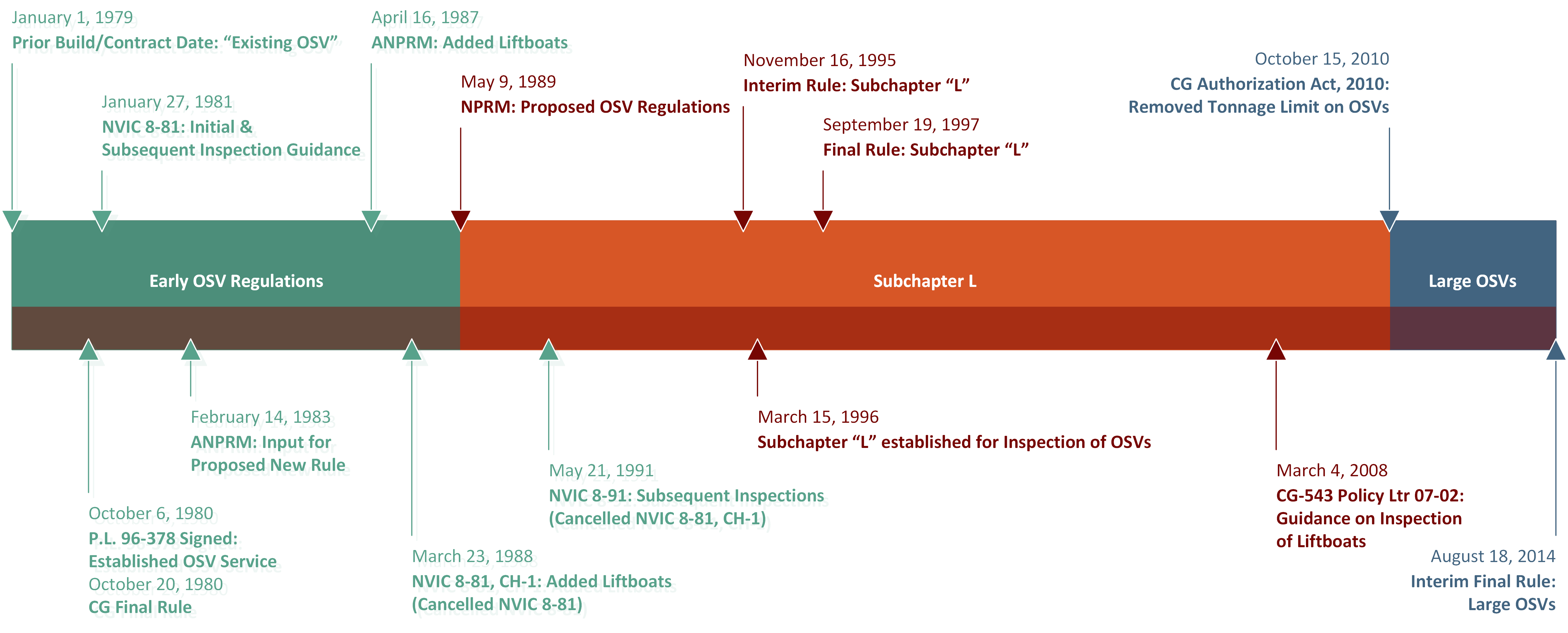The information on this page is available in the OCSNCOE's Introduction to Offshore Supply Vessels document, that includes both the regulatory history and an overview of the different types/categories of OSVs. A one-page regulatory summary is also available as the OCSNCOE's "OSV 101" document.
Just as the first offshore drilling rig Mr. Charlie prompted changes to the design for offshore drilling rigs, it also necessitated changes to the design of vessels carrying supplies, equipment, and personnel.
Carrying supplies and personnel by uninspected, single-engine, fishing, trawling, oyster, and surplus WWII vessels worked well to supply inland drilling and production facilities. However, these vessels were limited when it came to servicing the expanding offshore drilling and production facilities as they moved further from shore and into deeper water.
The limitations brought about a need for a new design of purpose-built vessels to carry the cargoes, deck equipment, and personnel needed to support the new offshore facilities.
Alden J. Laborde is credited with the vision to design and build the Ebb Tide, a vessel that could fulfill the offshore drilling and production industry’s needs.
Ebb Tide:
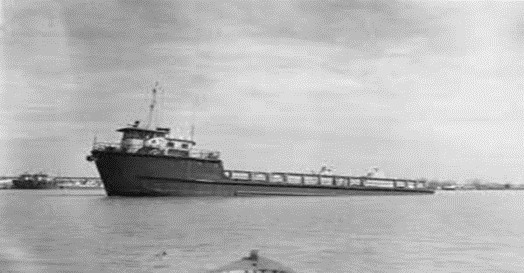
Ebb Tide – one of the first OSVs. (Photo by Maritime Logistics Professional)
The Ebb Tide was delivered and entered into service in 1956 for the company Tidewater.
With its accommodations and bridge forward and open deck aft, the new design allowed the vessel to carry more deck cargo and included tanks below deck for the carriage of bulk cargoes such as dry bulk, liquid mud, drilling fluids, potable water, and excess fuel.
As drilling expanded further offshore, larger vessels were needed to carry more supplies and equipment and perform additional support services.
Jehu Elevator:
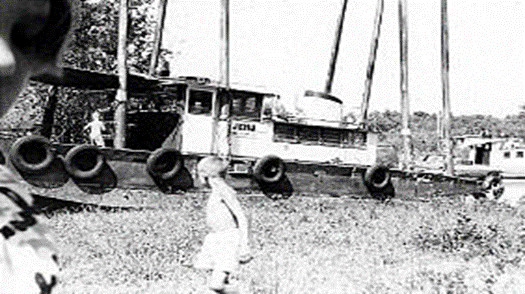
Jehu Elevator – the first liftboat. (Photo by elevating Boats, Inc.)
The Jehu Elevator was designed and built in 1955 by brothers, Lynn & Orin Dean, to address sea state conditions often experienced during seismographic research operations. The Dean Brothers had invented a new OSV type, a self-elevating vessel, commonly known as a “liftboat,” which has a wide array of uses today.
In primitive liftboat designs, the jacking systems were actuated with cable systems and were smaller and typically worked in shallower inshore waters. As liftboat technology developed, designs allowed for operation in deeper waters. Simultaneously, advancements in accommodations, cranes, open work decks, longer and stronger legs, and hydraulics jacking systems afforded the expanded use of liftboats.
The hazards associated with liftboat operations necessitated USCG’s need to address safety in this area (see NVIC 8-81 Ch.1 information below).
Regulatory History
Inspections:
OSVs were a new vessel with a particular purpose and design to support the offshore oil and gas industry. There were no specific regulations for the design and operations of OSVs that took into account their unique operational profile.
Some OSVs were inspected while others operated outside of the scope of the USCG.
Smaller vessels (less than 100 GT) carrying workers and small amounts of cargo to and from offshore facilities were inspected as small passenger vessels under the regulations of 46 CFR Subchapter T.
Vessels carrying deck and bulk cargoes were inspected as freight vessels under 46 CFR Subchapter I.
While the best fit for the time, the regulations did not adequately address or account for the uniqueness of supply vessel operations. Waivers and exemptions through policies or guidance were granted, allowing OSVs to perform services not otherwise permitted under regulations. For example, the allowance to carry and transfer excess fuel and drilling mud to offshore facilities was a privilege unique to the OSV fleet.
Some vessels servicing the offshore support industry were not inspected due to bareboat charter agreements that exempted vessels from USCG manning and inspection requirements. The bareboat charter loophole made enforcement of manning and inspection regulations difficult or, in some cases, impossible resulting in a fleet of inspected and uninspected vessels.
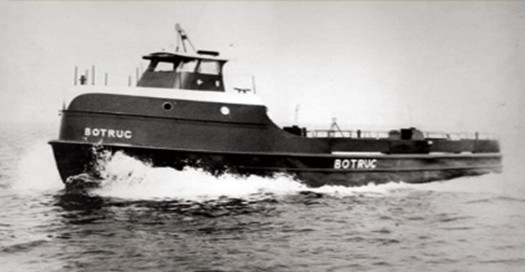
BoTruc – Another of the first OSVs. (Photo by Offshore Magazine)
The fleet continued to grow, and USCG efforts combined with Congressional pressure culminated in the passage of P.L. 96-378, requiring the inspection of all OSVs.
Public Law 96-378 “Small Vessel Inspection and Manning Act”
P.L. 96-378, enacted on October 6, 1980, changed existing laws regarding other small vessels and manning, but it also addressed OSVs by legally defining them and requiring them to be inspected. Examples of definitions that were brought about by the new law include the following:
An Offshore Supply Vessel (OSV) is a vessel that:
○ Is propelled by machinery other than steam,
○ Is not a “Passenger Vessel,”
○ Is of more than fifteen and less than five hundred gross tons, and
○ Regularly carries goods, supplies, or equipment in support of exploration, exploitation, or production of offshore mineral or energy resources.
Public Law 96-378 detailed provisions to allow vessels to enter certificated service as:
○ an “Existing OSV”-Certificated Prior to P.L. 96-378
○ an “Existing OSV”-Non-Certificated Prior to P.L. 96-378, or
○ a “New Vessel.”
An Existing OSV defined as:
○ a vessel operating as [an OSV] on or before January 1, 1979, or
○ a vessel, if not in service of any kind, on or before that date (January 1, 1979) and was contracted for and entered service before October 6, 1980.
A New OSV was defined as: not an “existing OSV.”
P.L. 96-378 also allowed exemptions from major structural or equipment standards for “existing OSVs” and required that on or after January 1, 1989, each “existing OSV” that is 20 years or older shall be subject to inspection as a “new OSV” (as defined in P.L. 96-378) under the applicable regulation subchapters.
Final Rule
On October 20, 1980, the USCG published its Final Rule in the Federal Register (45 FR 69243), providing the deadline and procedures for uninspected OSVs to be registered for inspection under the new law.
The Final Rule also impacted the inspection regime for “new OSVs,” requiring them to be inspected as OSVs using the regulations in 46 CFR Subchapters I or T.
Individually, OSVs under 100 GRT would be inspected under Subchapter T. Vessels over 100 GRT and less than 500 GRT would be required to be inspected using the regulations in Subchapter I.
Navigation and Vessel Inspection Circular (NVIC) 8-81
NVIC 8-81 was published in the Federal Register on July 27, 1981, to guide industry and USCG Marine Inspectors on the initial and subsequent procedures for inspecting uncertificated “existing” vessels under the new law.
NVIC 8-81 specified items and areas that should be given attention during the initial and subsequent inspection of OSVs. Topics include dry-docking, stability, inspections of pressure vessels, electrical, fire-fighting, and life-saving equipment, combustible and flammable piping systems, bilge systems, marine sanitation devices, and oil pollutions systems, fire control/safety plan, steering systems, and especially hazardous conditions.
NVIC 8-81 also guided carrying other “Persons Allowed”, allowing for the carriage of 16 “Persons in Addition to the Crew.”
Note: The allowance for individuals in addition to the crew originates from Title 46, U.S. Code 3304 “Transporting Individuals in Addition to the Crew.”
NVIC 8-81 Ch.1 superseded the original NVIC.
Advance Notice of Proposed Rule Making (ANPRM)
On February 14, 1983, the USCG published the first two ANPRMs in the Federal Register requesting industry’s input for the proposed new regulations for OSVs.
The purpose of the ANPRM was to solicit comments on the technical merits of the proposal and its probable economic effect.
The new proposed regulations were intended to consider these vessels’ particular characteristics, their method of operations, and the service in which they are engaged.
On April 16, 1987, the USCG published the second ANPRM requesting early public input and comments concerning a proposal to establish safety standards for liftboats.
The high rate of marine casualties caused by liftboats emphasized the need for specific regulations addressing the hazards inherent to their operations.
The USCG anticipated that the development and enforcement of standards, specifically addressing the unique hull forms and operating characteristics associated with liftboats, would significantly improve their safety record.
NVIC 8-81 Ch.1
Published in the Federal Register on March 23, 1988, as a means to address liftboats after the April 16, 1987 ANPRM was published.
NVIC 8-81 Ch.1 added liftboats to the inspections of OSVs and guidance for particular items and areas that should be inspected on liftboats.
These items and areas include freeboard, strength, stability, machinery piping systems, hydraulic systems, cranes, fire-fighting equipment, lifesaving equipment, operating manual, and vessel operations.
Additionally, Ch.1 included USCG manning standards for all OSVs, including liftboats.
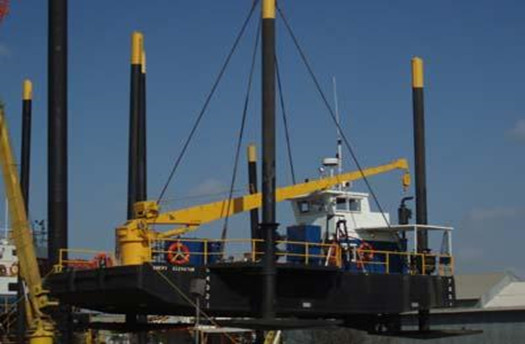
Photo by Cajun Stabilizing Boats, Inc.
Notice of Proposed Rule Making (NPRM)
On May 9, 1989, the USCG published a NPRM proposing new regulations for inspection and certification of new offshore supply vessels (OSVs), including liftboats.
This NPRM contained proposed regulations for new OSVs. The regulations would apply to conventionally-designed OSVs and liftboats.
The proposed regulations would consolidate existing OSV standards and policy into a single subchapter and make specific revisions to accommodate OSV’s unique characteristics, their methods of operation, and the types of service in which they are engaged.
Consideration was given that most of these vessels conducted operations in the Gulf of Mexico, although some were beginning to operate worldwide.
NVIC 8-91
NVIC 8-91 was published in the Federal Register on May 21, 1991. This NVIC provided following inspection requirements for OSVs that had been inspected under NVIC 8-81 or 8-81 Ch.1.
NVIC 8-91 addressed initial and subsequent inspections for smaller OSVs (<100 tons) operating in Lakes, Bays, and Sounds or other Inshore or Inland waters and, for existing liftboats that operate within the Boundary Line (12NM) to be conducted in accordance with this NVIC, in lieu of the stricter requirements of Subchapters T or I (as applicable).
NVIC 8-91 included Grandfathered Provisions for “existing” OSVs which are still in service after January 1998 (20yrs) are subject to be inspected as a “New” OSV and should be inspected by the Officer in Charge, Marine Inspection (OCMI) on a case-by-case basis to determine the extent that it complies with current regulations.
8-91 required that “Grandfathered” lifesaving and fire-fighting equipment, not previously replaced, must be replaced with USCG equipment approved to then-current standards. Other equipment and systems should be addressed on a case-by-case basis.
Some “existing” OSVs (as defined by P.L. 96-378) are still in service today and may even be inspected under NVIC 8-91 for most items, except fire-fighting and lifesaving equipment.
NVIC 8-91 cancelled NVIC 8-81 Ch.1.
Subchapter L Interim Rule
On November 16, 1995, the USCG published an Interim Rule in the Federal Register. The rule was Subchapter L that was applicable to OSVs, including liftboats, and provided additional public comments.
The Interim Rule became effective on March 15, 1996. OSVs certificated before March 15, 1996, could either comply with these regulations in their entirety or continue to comply with and to be certificated under current laws and policy (Subchapter T or I).
This rule contained many changes to the regulations and policies governing conventional OSVs at that time. It contained regulations specific to liftboats and made specific revisions to accommodate these vessels’ unique characteristics, their operation methods, and their types of service.
The Interim Rule defined Offshore Workers as an individual carried aboard an OSV, and employed in a phase of exploration, exploitation, or production of offshore mineral or energy resources served by the vessel. The new definition does not include the master or a member of the crew engaged in the business of the vessel, who has contributed no consideration for carriage aboard and is paid for services aboard.
Note: The term Offshore Worker only applies to OSVs inspected and certificated under Subchapter L.
The effective date of this Interim Rule effectively changed the definition of an “existing OSV” and a “New OSV” from the previous definitions of the P.L. 96-378.
Subchapter L Final Rule
On September 19, 1997, the USCG published the final rule, effective October 20, 1997.
The most significant aspect of 46 CFR Subchapter L is its consolidation of requirements for OSVs.
This rule adopted the interim rule as final with several changes and brought OSVs under a single, consistent regulatory regime.
The requirements of Subchapter L contained in the interim rule became effective on March 15, 1996. The final rule adopted the interim rule with a number of changes brought about primarily by the comments to the interim rule.
This final rule applies to new OSVs contracted for after the effective date of these regulations and OSVs that undergo major conversions after the effective date of these regulations and applies to existing OSVs, including pre-1979 OSVs, if the owners of these OSVs wish.
This new rule changed the definition of Existing offshore supply vessel to: “is one contracted for, or the keel of which was laid, before March 15, 1996.”
CG-543 Policy Letter 07-02
On March 4, 2008 CG-543 (now CG-CVC) published policy letter 07-02, “Guidance on the Inspection, Repair and Maintenance of all Liftboats”.
The policy provided guidance for inspection of all liftboats regardless of the applicable subchapters, and supplements the information in NVIC 8-91.
Public Law 111-281 “USCG Authorization Act 2010” P.L. 111-281 removed statutory limitations placed upon OSVs from its original definition in P.L. 96-378, allowing OSVs > 6000 GT ITC to be inspected under Subchapter L.
The law also addressed manning, licensing, and deck watches onboard larger OSVs.
P.L. 111-281 required large OSVs built after August 1, 2010, to meet the standards of Regulation 12A of Annex I in MARPOL if the aggregate capacity of fuel oil was 600 cubic meters or more, regardless of whether or not the vessel is engaged in coastwise trade or is on an international voyage.
Following the passage of the Act, the USCG was directed promulgate regulations regarding large OSVs and adjust mariners’ licenses to meet the new tonnage.
Additionally, P.L. 111-281 ordered the USCG to publish an Interim Final Rule as a temporary regulation implementing the new law for OSVs of at least 6000 gross tons ITC and to ensure the safe carriage of oil, hazardous substances, and individuals in addition to the crew on such OSVs.
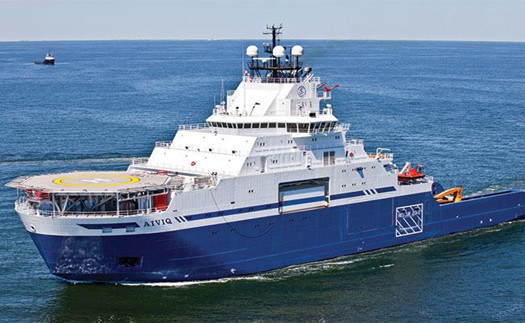
Photo by Edison Chouest Offshore.
Large OSV Interim Rule
On August 18, 2014, the USCG published an Interim Rule in the Federal Register, which was put into regulations following comments from the public.
The new law and regulations made the following changes:
○ No tonnage limits on OSVs.
○ The Final Regulations would be published in 46 CFR Subchapter L.
○ Compliance with portions or the entirety of International standards, regardless of voyage type.
Note: The current regulations are comprised only of those published in the interim rule. The USCG has not released a Final Rule concerning Large OSVs (> 6000 GT ITC).
Applicable Subchapters
As we learned by the regulatory history, the subchapter to which an OSV is built and inspected is dependent on the year built, and the type of service at the time of delivery.
OSVs may be inspected and certificated under several subchapters. Below is a summarized description of the applicability for each subchapter.
*Subchapter T
Subchapter T applies to OSVs <100 tons carrying persons in addition to the crew with keel laid date before March 15, 1996, and completed before March 16, 1998. These were mostly crew boats and a few utility vessels. Many are still in operation today.
Subchapter T is still an option for vessels <100 tons built for service in the offshore energy industry.
*Subchapter I
Subchapter I applies to OSVs transporting cargo or freight with keel laid date before March 15, 1996, and completed before March 16, 1998. These vessels are inspected to the Subchapter I regulations in force at the time of construction.
This subchapter applies to OSVs >100 GRT built in compliance with the dates, as stated above.
Some smaller OSVs (<100 tons GRT) had the option to select this option (see *Note below). But OSVs >100 tons were required to choose the Subchapter I option.
*Note: OSVs <100 GRT with keel laid date before March 15, 1996, and completed before March 16, 1998, had the option of inspection under Subchapters T or I, depending on the type of service.
Also, OSVs of at least 6000 GT ITC with a keel laid date before August 18, 2014, and completed by August 18, 2016, were inspected under Subchapter I. Again, these vessels are inspected under the Subchapter I regulations in force at the time of construction.
Vessels constructed and certificated as Subchapter I after the dates listed above are not considered an OSV unless otherwise stated on the COI that they are multi-certificated. See multi-certificated information below.
Subchapter L
Applies to all OSVs with keel laid date on or after March 15, 1996, and OSVs that were completed after March 16, 1998.
Also, OSVs of at least 6000 GT ITC with a keel laid date after August 18, 2014, and/or completed after August 18, 2016.
Multi-Certificated
Multi-certificated OSVs are OSVs that have plans reviewed and pre-approved and that have been inspected and certificated to conduct multiple services without having to be re-inspected when changing service.
Some of the factors related to Multi-certification include:
○ Only one COI is issued and endorsed with the types of services allowed.
○ The Master is to make a notation in the ship’s logs when the service of the vessel is changed.
○ A change in service may affect the service and cargo carriage allowances.
○ A change in service may also affect the vessel’s manning requirements.
Note: As of the time of publication, there are NO National Policies or Regulatory Guidance regarding Multi-Certification of Offshore Supply Vessels. USCG District 8 Policy Letter 09-2001, “Certification of Multi-Service Offshore Supply Vessels (OSVs),” provides guidance on OSVs certificated as an OSV and freight and/or industrial vessel. The policy is only applicable in District Eight, though OCMIs in other regions may use it as a reference for determinations in their respective zones.
A timeline depicting the previously discussed regulatory events is shown below (click on the timeline to open the image in a new window, in a larger format).
